
limestone sculpture 
sandstone sculpture 
marble sculpture 
alabaster sculpture 
talcstone sculpture 
hebel, concrete sculpture |
Sculpting in stone is challenging and gratifying work.
I work in a range of stone and sometimes the client will have a particular stone that they wish me to work. To see examples of some of my stone sculpture, click on the material of your choice:
- Limestone
- Sandstone
- Marble
- Other stones
- Hebel autoclaved concrete
I choose the type of stone based upon the following criteria:
- the story of the sculpture
- the siting of the sculpture
- the size and shape of the sculpture
- my client's preferences
- my client's budget.
These criteria involve my consideration of factors such as the strength of the stone, its suitability in colour, cost, shape and size, durability in weather, potential of vandalism, engineering of supporting structures, access for delivery.
If the work is to be from an irregularly shaped stone, as opposed to a rectangular prism cut from a larger block, I endeavour to work to the very edges of the rock. This increases the challenge of the work but the strength of the original shape is translated into the finished sculpture.
To sense the form within, I set it where I can see it often and let my subconscious play with the shapes of the stone. Then the stone reveals the potential within.
At that time, I may make sketches or a scaled maquette of the rock in plasticine or clay and then carve out areas to create the shape that I have imagined.
This all takes time and its therefore good for you to spend time with a sculpture to discover what you like. If you can do so, feel out its curves, noticing how they travel around the sculpture. Imagine what it may have looked like as a jagged, dull-surfaced rock.
Ask yourself questions to stimulate your perception. You can play with thoughts such as, why do I like/not like the work, are there particular bits that I like, what does the sculpture mean to me, are there any other ways to view this object?
Here are some notes on the stone that I've used to date.
Limestone
The beds of ancient coral reefs, compacted over time, yield limestone. Having this biological background, this stone invests life into the organic forms that I love to create from it.
Its creamy colouring is enriched by the inclusion of visible fossils and shells in its structure.
This stone is soft and, similar to sandstone, will colour and grow lichens and mosses when placed outside.
It may be sealed to minimise these effects of weathering.
Sandstone
Featured in many of our heritage buildings, Hawkesbury Sandstone is a well loved, locally available stone. It is a durable and beautiful stone that is a pleasure to work.
With careful selection from its extraordinary range of colours it can suit almost any decor.
Yass Black Marble
When limestone is subjected to pressure and the heat of volcanic activity, marble is created.
This marble is quite unique, in that we can still see some of the original shells and other fossils that comprise its structure.
Polishing is done by hand with increasingly fine grits of sandpaper. Finally a polishing powder applied with a hessian pad, and a lot of elbow grease, produce the mirror finish.
Wombeyan Marble
Quarried from the South Coast of NSW, this marble has very large, visible crystals. Its colour can vary from white through reds and oranges depending upon mineral take-up during its creation.
Wombeyan is the softer of the two Australian marbles. I prefer a honed rather than polished finish for the Wombeyan, and I think that it makes it a more inviting surface to touch.
Carrara Marble
Carrara Marble has been mined for thousands of years in Carrara, Italy. Its homogeneity, fine grain size, softness and figuring make it a delight to carve.
Scaglione Alabaster
Unobtainable in Australia, this material occurs in only one part of Italy. There each stone is mined by hand in order to avoid bruising.
Typically, it is geologically deposited in egg-shaped boulders of varying size.
It is highly prized for its unique translucence.
Talcstone
Mined in Australia, talc is a very soft stone to carve. I design each work around the colouring, inclusions and cracks that are typical of this stone.
Some stones can contain an extraordinary range of colours. Colours commonly range from white through reds, browns and greens.
Slate
Slate is a sedimentary stone found in Australia. It is a great stone to carve.
Good quality slate, that is to say, a stone that is sound, dense and free from inclusions such as clay is difficult to find.
Hebel Autoclaved Concrete
'Hebel' is a soft, aerated block of concrete. It comes in a range of sizes and is very like limestone in its ease of carving.
It can be carved and left in its natural state, which I find quite attractive, or a range of finishes can be applied.
Large works can be created by glueing the blocks together.
Roger Apte
~ Roger Apte SCULPTOR ~ |






